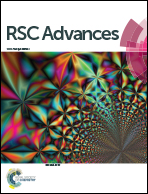New functionalized MIL-53(In) solids: syntheses, characterization, sorption, and structural flexibility†
Abstract
The syntheses and characterization of a series of functionalized MIL-53(In) solids have been reported. Chemical groups with variations in steric hindrance and chemical nature (–(OH)2, –Br or –NO2 groups) were introduced through the terephthalate linker to modify the pore surface. Single crystal X-ray diffraction data, N2 adsorption–desorption isotherms, and infrared spectra were systematically investigated to explore the impact of the functional groups grafted onto the organic linker on the dynamic behaviour of these highly flexible hybrid porous frameworks. Owing to the distinctive steric hindrance and chemical nature, the different substituents can influence the interactions between the framework and the trapped molecules, further influencing the flexibility of the materials. Dihydroxyl modified MIL-53(In) exhibits no nitrogen accessible porosity. Notably, functionalization by –Br and –NO2 groups leads to the different capabilities of the corresponding solids to accommodate N2 molecules.



 Please wait while we load your content...
Please wait while we load your content...